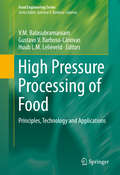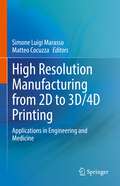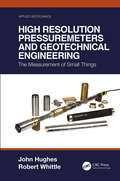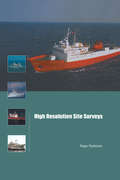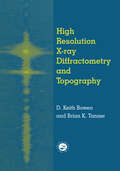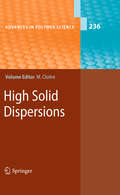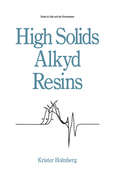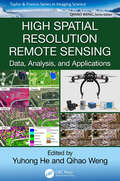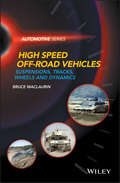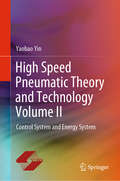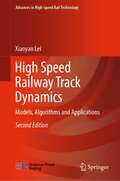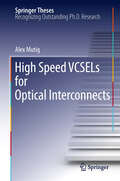- Table View
- List View
High Power Microwaves (Series in Plasma Physics)
by Peng Zhang James Benford John A. Swegle Edl Schamiloglu Jacob Coty StephensFollowing in the footsteps of its popular predecessors, High Power Microwaves, Fourth Edition continues to provide a wide-angle, integrated view of the field of high power microwaves (HPMs). This fourth edition includes significant updates in every chapter as well as a new chapter on High Power Amplifiers. Written by a range of experimentalists, theorists, and applied theorists, the book offers complementary perspectives on different source types. The authors address: How HPM relates historically and technically to the conventional microwave field The possible applications for HPM and the key criteria that HPM devices have to meet in order to be applied How high power sources work, including their performance capabilities and limitations The broad fundamental issues to be addressed in the future for a wide variety of source types The book is accessible to several audiences. Researchers currently in the field can widen their understanding of HPM. Present or potential users of microwaves will discover the advantages of the dramatically higher power levels that are being made available. Newcomers to the field can pursue further research. Decision makers in direct energy acquisition and related fields, such as radar, communications, and high-energy physics, can see how developments in HPM will affect them.Key Features Discusses the key criteria that must be fulfilled for emerging applications of HPMs in addition to the HPM formulary of practical equations for everyday work Describes the broad fundamental issues for each class of HPM sources and clarifies HPM capabilities and limitations on performance Uses a format suitable for classroom instruction with updated problems in each chapter alongside references and guidance to the literature for readers seeking more details. Solutions to the problems are available at schamiloglu@me.com.
High Pressure Fluid Technology for Green Food Processing
by Tiziana Fornari Roumiana P. StatevaThe aim of this book is to present the fundamentals of high pressure technologies from the perspective of mass transfer phenomena and thermodynamic considerations. Novel food applications are exposed and their relation to chemical analysis, extraction, reaction and particle formation processes are outlined. The chapters are written by a diverse group of scientists with expertise in chemistry, food processes, analytical chemistry, chemical engineering and chemical engineering thermodynamics, and biotechnology. The mission of green food engineering is to promote innovative technologies that reduce or eliminate the use or generation of hazardous materials (solvents, reagents) in the design and operation of food related processes, with the view to improve food safety and quality. Several efficient, environmentally friendly and benign technologies based on the use of high pressure and green solvents have demonstrated to be sustainable alternatives to traditional processes in the food industry. Although hundreds of new ideas are being published in the open literature, reliable engineering tools to simulate and design those processes are still under development. High Pressure Fluid Technology for Green Food Processing presents in-depth analyses and outlines the ways towards their maturity. Tiziana Fornari, Research Institute of Food Science (CIAL) Universidad Autonoma de Madrid, Madrid, Spain Roumiana P. Stateva, Institute of Chemical Engineering, Bulgarian Academy of Sciences, Sofia, Bulgaria
High Pressure Materials Properties: A Supplement to Landolt-Börnstein IV/22 Series
by Yoshiyuki Kawazoe Ryunosuke Note Takeshi KanomataThe subject of this supplement to Landolt-Börnstein IV/22 Series is to present both the numerical and graphical data on the various magnetic properties of materials under pressure. Data for transition metal binary oxides MmOn [M: transition metals, O: oxygen, m, n: 1~15], MXO [M: transition metals, X: F, Cl, Br, O: oxygen] and MM’On [M: transition metals, M’: transition metals or non-transition metal elements, O: oxygen, n=2, 2.5, 3] ternary oxides are presented.As well known, the data-compiling principle in the Landolt-Bӧrrnstein series is to choose the best reliable values from many available experimental data. The present compilation is done according to this principle.
High Pressure Processing of Food
by V. M. Balasubramaniam Gustavo V. Barbosa-Cánovas Huub L.M. LelieveldHigh pressure processing technology has been adopted worldwide at the industrial level to preserve a wide variety of food products without using heat or chemical preservatives. High Pressure Processing: Technology Principles and Applications will review the basic technology principles and process parameters that govern microbial safety and product quality, an essential requirement for industrial application. This book will be of interest to scientists in the food industry, in particular to those involved in the processing of products such as meat, fish, fruits, and vegetables. The book will be equally important to food microbiologists and processing specialists in both the government and food industry. Moreover, it will be a valuable reference for authorities involved in the import and export of high pressure treated food products. Finally, this update on the science and technology of high pressure processing will be helpful to all academic, industrial, local, and state educators in their educational efforts, as well as a great resource for graduate students interested in learning about state-of-the-art technology in food engineering.
High Pressure Processing of Fruit and Vegetable Products (Contemporary Food Engineering)
by Milan Houška Filipa Vinagre Marques da SilvaHigh pressure processing is a fast-growing food processing technology and opens the door to nearly-fresh products that retain their sensorial and nutritional qualities. High Pressure Processing of Fruit and Vegetable Products reviews and summarizes the latest advances in novel high-pressure processing techniques for preserving fruits, fruit juices, and their mixtures. It contains basic information on the relation of high-process treatment parameters with the safety and quality of fruit and vegetable juices/products. The book focuses on product quality parameters, nutritional value, bio-active health components, and microbial safety and stability. <P><P> The main aim of this book is to summarize the advances in the utilization of modern high pressure pasteurization (HPP) treatment to preserve and stabilize fruit and vegetable products. HPP technology is related to the product quality parameters, the content of nutritional and health active components, and the microbial safety and subsequent shelf life. <P><P> One chapter of this book is devoted to industrial equipment available; other chapters deal with examples of commercial fruit and vegetable products. Another chapter of this book is dedicated to packaging, as packaging of food before HPP is mandatory in this technology. The regulatory aspects for high-pressure treated fruit and vegetable products in different regions of the world (Europe, the United States, Asia, and Australia) are also an important topic dealt within one chapter of the book. The effects of HPP technology on the quality of fruit and vegetable products, namely nutrients and stability, health active components, and sensory aspects, are reviewed in a trio of chapters.
High Pressure Surface Science and Engineering (Series in Material Science and Engineering)
by Yury Gogotsi V. DomnichIn many instances of mechanical interaction between two materials, the physicalcontact affects only the outermost surface layer, with little discernible influence on the bulk of the material. The resultant high pressures in these localised regimes can induce surface structural changes such as deformation, phase transformation and amorphization.
High Resolution Manufacturing from 2D to 3D/4D Printing: Applications in Engineering and Medicine
by Simone Luigi Marasso Matteo CocuzzaThis book provides a comprehensive presentation of the most frequently used high resolution manufacturing techniques available, as well as the polymeric materials used for each of the techniques. Divided into two parts covering the technologies and materials used and the impact on different research fields and case studies, High Resolution Manufacturing from 2D to 3D/4D Printing: Applications in Engineering and Medicine addresses issues like throughput improvement by volumetric 3D printing and presenting novel applications and case studies. In addition, this book also covers the latest breakthrough developments and innovations to help readers understand the future applications of this technology across various disciplines, including biomedicine, electronics, energy, and photonics.
High Resolution Pressuremeters and Geotechnical Engineering: The Measurement of Small Things (Applied Geotechnics Ser.)
by John Hughes Robert WhittleHigh Resolution Pressuremeters and Geotechnical Engineering focuses on pressuremeters with internal transducers that allow measurement of strength, stiffness and in situ reference stress. It outlines the principles and the basics of the technology, gives guidance on good practice and making reliable analysis, provides case studies, and compares the pressuremeter test with similar ones from other devices to enable engineers to make informed choices. A unique, up-to-date guide to high resolution pressuremeters with internal transducers Contextualises analyses and advice to enable an informed choice of testing processes Presents analyses previously unpublished in book form This practical guide will suit professionals at the consultancy level, pressuremeter practitioners and site investigation companies.
High Resolution Site Surveys
by Roger ParkinsonHigh Resolution Site Surveys brings together the full range of site surveying techniques for the first time, to provide a unified approach to marine and land-based resolution surveying.Detailed descriptions are given of digital seismic survey methods, hydrographic 'analogue' search and survey tools, non-seismic survey techniques, and positioning sy
High Resolution X-Ray Diffractometry And Topography
by Brian K. Tanner D.K. BowenThe rapid growth in the applications of electronic materials has created an increasing demand for reliable techniques for examining and characterizing these materials. This book explores the area of x-ray diffraction and the techniques available for deployment in research, development, and production. It maps the theoretical and practical background necessary to study single crystal materials using high resolution x-ray diffraction and topography. It combines mathematical formalism with graphical explanations and hands-on advice for interpreting data, thus providing the theoretical and practical background for applying these techniques in scientific and industrial materials characterization
High Rise and Fall: The Making of the European Real Estate Industry
by Andrea CarpenterHigh Rise and Fall tells the story of how the European commercial property industry transformed from a local, small-scale business to an international, financially sophisticated, multi-billion-euro industry that was ultimately devastated by the 2008 crash. Drawing on her experience as both former Editor of EuroProperty and Director at the European Association for Investors in Non-Listed Real Estate Vehicles (INREV), Andrea Carpenter explains how the mid-1990s saw the arrival of a new style of property investing in the European markets. Seeking high returns, impervious to risk and with a seeming indifference to the buildings at the heart of the deals, US players such as Morgan Stanley, Goldman Sachs and Lehman Brothers conquered the European property markets with an audacity that both repulsed and intoxicated the locals. Fuelled by improving economic conditions in the early 2000s, European investors were keen to emulate all or parts of the US investors’ philosophy. Armed with a wall of capital, the industry expanded into the far reaches of Europe in search of returns, and piled on new risks that it did not completely understand. In her highly readable style, Carpenter analyses the mistakes made by the industry in the run-up to the crash when billions were wiped off the value of property across the region, and it became clear that in the pursuit of high returns and a place in the wider financial world, the industry had turned its back on the basics – bricks and mortar. This book is aimed at students and younger professionals studying or working in the real estate industry who need to understand the events that shaped the world they are entering into, and the lessons that can be learned from them.
High Sensitivity Magnetometers
by Asaf Grosz Michael J. Haji-Sheikh Subhas C. MukhopadhyayThis book gathers, for the first time, an overview of nearly all of the magnetic sensors that exist today. The book is offering the readers a thorough and comprehensive knowledge from basics to state-of-the-art and is therefore suitable for both beginners and experts. From the more common and popular AMR magnetometers and up to the recently developed NV center magnetometers, each chapter is describing a specific type of sensor and providing all the information that is necessary to understand the magnetometer behavior including theoretical background, noise model, materials, electronics, design and fabrication techniques, etc.
High Solid Dispersions
by Michel CloitreFrom Polymers to Colloids: Engineering the Dynamic Properties of Hairy Particles, by D. Vlassopoulos and G. Fytas * Nonlinear Rheological Properties of Dense Colloidal Dispersions Close to a Glass Transition Under Steady Shear, by M. Fuchs * Micromechanics of Soft Particle Glasses, by R. T. Bonnecaze and M. Cloitre * Quantitative Imaging of Concentrated Suspensions Under Flow, by L. Isa, R. Besseling, A. B. Schofield and W. C. K. Poon * Soft and Wet Materials: From Hydrogels to Biotissues, by J. P. Gong and Y. Osada
High Solids Alkyd Resins
by K. HolmbergThis book covers the chemistry of high solids compositions and focuses on the binder component and on the solvent. It discusses factors controlling the viscosity and the solid content of alkyd resins. The book describes different approaches to preparing high solid alkyds.
High Spatial Resolution Remote Sensing: Data, Analysis, and Applications (Imaging Science)
by Yuhong He and Qihao WengHigh spatial resolution remote sensing is an area of considerable current interest and builds on developments in object-based image analysis, commercial high-resolution satellite sensors, and UAVs. It captures more details through high and very high resolution images (10 to 100 cm/pixel). This unprecedented level of detail offers the potential extraction of a range of multi-resource management information, such as precision farming, invasive and endangered vegetative species delineation, forest gap sizes and distribution, locations of highly valued habitats, or sub-canopy topographic information. Information extracted in high spatial remote sensing data right after a devastating earthquake can help assess the damage to roads and buildings and aid in emergency planning for contact and evacuation. To effectively utilize information contained in high spatial resolution imagery, High Spatial Resolution Remote Sensing: Data, Analysis, and Applications addresses some key questions: What are the challenges of using new sensors and new platforms? What are the cutting-edge methods for fine-level information extraction from high spatial resolution images? How can high spatial resolution data improve the quantification and characterization of physical-environmental or human patterns and processes? The answers are built in three separate parts: (1) data acquisition and preprocessing, (2) algorithms and techniques, and (3) case studies and applications. They discuss the opportunities and challenges of using new sensors and platforms and high spatial resolution remote sensing data and recent developments with a focus on UAVs. This work addresses the issues related to high spatial image processing and introduces cutting-edge methods, summarizes state-of-the-art high spatial resolution applications, and demonstrates how high spatial resolution remote sensing can support the extraction of detailed information needed in different systems. Using various high spatial resolution data, the third part of this book covers a range of unique applications, from grasslands to wetlands, karst areas, and cherry orchard trees.
High Speed Catamarans and Multihulls: Technology, Performance, And Applications
by Alan Bliault Liang Yun Huan Zong RongHigh speed catamaran and multihull high speed marine vessel have become very popular in the last two decades. The catamaran has become the vessel of choice for the majority of high speed ferry operators worldwide. There have been significant advances in structural materials, and structural design has been combined with higher power density and fuel efficient engines to deliver ferries of increasing size. The multihull has proven itself to be a suitable configuration for active power projection across oceans as well as for coastal patrol and protection, operating at high speedd for insertion or retrieval with a low energy capability. At present there is no easily accessible material covering the combination of hydrodynamics, aerodynamics, and design issues including structures, powering and propulsion for these vehicles. Coverage in High Speed Catamarans and Multihulls includes an introduction to the history, evolution, and development of catamarans, followed by a theoretical calculation of wave resistance in shallow and deep water, as well as the drag components of the multihull. A discussion of vessel concept design describing design characteristics, empirical regression for determination of principal dimensions in preliminary design, general arrangement, and methods is also included. The book concludes with a discussion of experimental future vehicles currently in development including the small waterplane twin hull vessels, wave piercing catamarans, planing catamarans, tunnel planing catamarans and other multihull vessels.
High Speed Off-Road Vehicles: Suspensions, Tracks, Wheels and Dynamics (Automotive Series)
by Bruce MaclaurinA concise reference that provides an overview of the design of high speed off-road vehicles High Speed Off-Road Vehicles is an excellent, in-depth review of vehicle performance in off-road conditions with a focus on key elements of the running gear systems of vehicles. In particular, elements such as suspension systems, wheels, tyres, and tracks are addressed in-depth. It is a well-written text that provides a pragmatic discussion of off-road vehicles from both a historical and analytical perspective. Some of the unique topics addressed in this book include link and flexible tracks, ride performance of tracked vehicles, and active and semi-active suspension systems for both armoured and unarmoured vehicles. The book provides spreadsheet-based analytic approaches to model these topic areas giving insight into steering, handling, and overall performance of both tracked and wheeled systems. The author further extends these analyses to soft soil scenarios and thoroughly addresses rollover situations. The text also provides some insight into more advanced articulated systems. High Speed Off-Road Vehicles: Suspensions, Tracks, Wheels and Dynamics provides valuable coverage of: Tracked and wheeled vehicles Suspension component design and characteristics, vehicle ride performance, link track component design and characteristics, flexible track, and testing of active suspension test vehicles General vehicle configurations for combat and logistic vehicles, suspension performance modelling and measurement, steering performance, and the effects of limited slip differentials on the soft soil traction and steering behavior of vehicles Written from a very practical perspective, and based on the author’s extensive experience, High Speed Off-Road Vehicles provides an excellent introduction to off-road vehicles and will be a helpful reference text for those practicing design and analysis of such systems.
High Speed Pneumatic Theory and Technology Volume II: Control System and Energy System
by Yaobao YinThis book highlights the latest developments and the author’s own research achievements in high speed pneumatic control theory and applied technology. Chiefly focusing on the control system and energy system, it presents the basic theory and pioneering technologies for aerospace and aviation, while also addressing e.g. pneumatic servo control theory, pneumatic nonlinear mechanisms, aerothermodynamics, pneumatic servo mechanisms, and sample applications of high temperature and high speed gas turbine systems in aerospace, aviation, and major equipment.
High Speed Rail and Access Transit Networks
by Lara Rita BrunelloThis book examines the promise of High Speed Rail (HSR) technologies to win market share from carbon-intensive air transport through the strategic optimization of rail productivity and efficiency. While the positive impacts of HSR at both urban and long-distance levels are well-documented, this resource focuses on what has been a challenging area for HSR deployment historically: the integration of HSR accessibility at the regional level. The author provides tools and methods to better measure the feasibility of integrating regional HSR with existing transport networks, and includes in-depth case studies to demonstrate the contributions of expanded high speed rail access on sustainable development.Shares options for maximizing efficiency and effectiveness of high speed rail transport;Compares strategies for integrating urban, long-distance, and regional high speed rail transport;Explores new dimensions of high speed rail deployment by linking transit networks with increased regional accessibility.
High Speed Rail in the US
by Thomas LynchThis book is intended to help fill some of the technical and policy information gaps identified earlier as sources constraining further development of high speed rail (HSR) systems in the US. It addresses the key aspects of planning, development and implementation of HSR systems.
High Speed Rail in the US: Super Trains for the Millennium
by Thomas LynchAn original approach for dealing with High Speed Rail (HSR) transportation development in the United States, this book serves as a blueprint for such development by providing an in-depth evaluation of the different systems and their inherent linkage to other transportation modes, their potential costs, financing options, system benefits, the curren
High Speed Railway Track Dynamics: Models, Algorithms and Applications (Advances in High-speed Rail Technology)
by Xiaoyan LeiThe second edition of this book systematically summarizes the latest research findings on high-speed railway track dynamics, made by the author and his research team over the past decade. It explores cutting-edge issues concerning the basic theory of high-speed railways, covering the dynamic theories, models, algorithms and engineering applications of the high-speed train and track coupling system. Presenting original concepts, systematic theories and advanced algorithms, the book places great emphasis on the precision and completeness of its content. The chapters are interrelated yet largely self-contained, allowing readers to either read through the book as a whole or focus on specific topics. It also combines theories with practice to effectively introduce readers to the latest research findings and developments in high-speed railway track dynamics. It offers a valuable resource for researchers, postgraduates and engineers in the fields of civil engineering, transportation, highway and railway engineering.
High Speed Serdes Devices and Applications
by Clarence Rosser Ogilvie Amanullah Mohammad James Donald Rockrohr Kent Dramstad Jeanne Trinko Mechler Michael A. Sorna David Robert StaufferThe material provides the reader with an understanding of the features and functions typically found on HSS devices. It explains how these HSS devices are used in protocol applications and the analysis which must be performed to use such HSS devices. The book is an assimilation of various topics with a focus on what chip designers need to understand in order to design chips using HSS cores. The reader is first introduced to the basic concepts and the resulting features and functions typical of HSS devices. HSS devices are used in the context of a protocol application. The reader is then introduced to the basic concepts used by protocols, and overviews are provided for several protocol standards in which HSS devices are commonly used. Additional chapters describe the features, functions, and considerations associated with designing and analyzing a reference clock distribution network, as well as testing HSS hardware, analyzing signal integrity, and analyzing power consumption. Finally, any HSS core is not complete without a set of design kit models to facilitate integration within the chip design, and special topics uniquely related to design kits for HSS cores are discussed in the final chapter.
High Speed VCSELs for Optical Interconnects
by Alex MutigThe transmission speed of data communication systems is forecast to increase exponentially over the next decade. Development of both Si-based high-speed drivers as well as III-V-semiconductor-based high-speed vertical cavity surface emitting lasers (VCSELs) are prerequisites for future ultrahigh data-rate systems. This thesis presents: - a survey of the present state of the art of VCSELs - a systematic investigation of the various effects limiting present VCSELs - a catalogue of solutions to overcome present limits - detailed progress in modelling, fabricating and testing the currently most advanced VCSELs at the two commercially most important wavelengths.
High Speed and Wide Bandwidth Delta-Sigma ADCs
by Lucien J. Breems Muhammed Bolatkale Kofi A. A. MakinwaThis book describes techniques for realizing wide bandwidth (125MHz) over-sampled analog-to-digital converters (ADCs) in nano meter-CMOS processes. The authors offer a clear and complete picture of system level challenges and practical design solutions in high-speed Delta-Sigma modulators. Readers will be enabled to implement ADCs as continuous-time delta-sigma (CT∆Σ) modulators, offering simple resistive inputs, which do not require the use of power-hungry input buffers, as well as offering inherent anti-aliasing, which simplifies system integration. The authors focus on the design of high speed and wide-bandwidth ΔΣMs that make a step in bandwidth range which was previously only possible with Nyquist converters. More specifically, this book describes the stability, power efficiency and linearity limits of ΔΣMs, aiming at a GHz sampling frequency.



